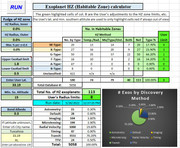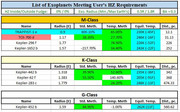There are now 5058 exoplanets listed in the exoplanet.eu catalog.
The results are the same as before with 113 in the HZ but only 8 exoplanets about the size of Earth (radii shown).

Here are those 8 per star type:

[Again, the red highlight simply means it isn't observable from the US (i.e. Tuscalosa).
I've been tweaking the program, as usual, and by adjusting for the HZ expansion line outward due to eccentric orbits, there seems to be no significant change to the count.
Eccentricities, per one paper, show an increase in the radiant flux received from the star. Given that high eccentricities gives a planet much more time farther from the star (ie colder regions) then it is non-intuitive, at least for me, that more heat is received. Of course, the inverse square law makes-up the difference during periapsis, no doubt, but it's still not intuitive.
The results are the same as before with 113 in the HZ but only 8 exoplanets about the size of Earth (radii shown).

Here are those 8 per star type:

[Again, the red highlight simply means it isn't observable from the US (i.e. Tuscalosa).
I've been tweaking the program, as usual, and by adjusting for the HZ expansion line outward due to eccentric orbits, there seems to be no significant change to the count.
Eccentricities, per one paper, show an increase in the radiant flux received from the star. Given that high eccentricities gives a planet much more time farther from the star (ie colder regions) then it is non-intuitive, at least for me, that more heat is received. Of course, the inverse square law makes-up the difference during periapsis, no doubt, but it's still not intuitive.




